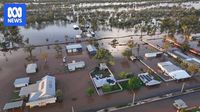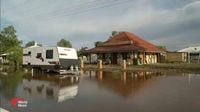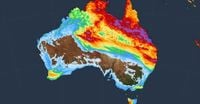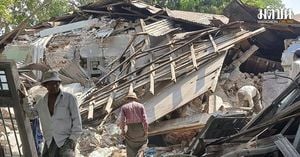The flood emergency in Queensland's south-west has escalated into one of the most devastating natural disasters in recent memory, affecting an area larger than the combined size of Victoria, Tasmania, and New Zealand. Homes have been inundated, vital infrastructure such as sheds, machinery, and fences have been destroyed, and tens of thousands of livestock have perished. The federal government has stepped in, deploying military resources to assist with fuel and fodder drops in a bid to mitigate further losses among the beleaguered agricultural community.
Tropical low Dianne, which made landfall on the Kimberley coast early on Saturday morning, March 29, 2025, has since weakened but continues to unleash heavy rainfall across already swollen rivers and creeks. As of Monday, March 31, flood watches and warnings are in effect across more than 3,000 kilometers of Australia, with many graziers forced to abandon their properties amid rising waters.
In the town of Thargomindah, floodwaters breached a makeshift levee wall overnight, leading to the inundation of multiple homes. Many residents had already evacuated to the airport terminal, the highest ground available, as they braced for the worst. The Bureau of Meteorology has warned that the floods could reach levels not seen in the region for over 50 years, since the catastrophic events of 1974.
As the situation worsens, both federal and state governments have mobilized disaster relief funding to aid recovery efforts in the affected areas. Councils including Barcoo, Boulia, Bulloo, Diamantina, Longreach, Quilpie, and Winton are now eligible for the Disaster Recovery Funding Arrangements, which will help support clean-up and recovery initiatives.
Local residents in Thargomindah are grappling with the reality of their situation, feeling as though they are in a "losing battle" against the relentless floodwaters. The makeshift levee built by locals over the weekend has already failed, exacerbating the crisis as more water from upstream continues to flow into the town.
On March 31, Opposition Leader Peter Dutton and Nationals Leader David Littleproud visited the area, pledging $10 million for a new radar system to enhance weather monitoring and improve response efforts in future emergencies. Their visit underscores the urgency of the situation, as communities brace for the possibility of prolonged isolation due to flooding.
The scale of the disaster has drawn comparisons to past catastrophic floods, with the current inundation described as the worst in over half a century. Small towns like Eulo and Thargomindah are among the hardest hit, with reports indicating that entire communities may face weeks of isolation as floodwaters continue to rise.
Residents are left to wonder when the floodwaters will peak, with many feeling a mix of anxiety and helplessness as they watch their homes and livelihoods wash away. The emotional toll on the community is palpable, as families are displaced and local businesses face uncertain futures.
As the crisis unfolds, the resilience of the affected communities is being tested. Local leaders and residents are rallying together, sharing resources and support in a bid to weather the storm. However, the road to recovery will undoubtedly be long and fraught with challenges.
With floodwaters still rising and more rain forecasted, the situation remains critical. The federal government’s military assistance and the promised disaster relief funding are steps in the right direction, but the immediate needs of those affected must be prioritized to prevent further loss of life and property.
In the coming days, as the full extent of the damage becomes clearer, the focus will shift to recovery and rebuilding efforts. Community leaders are calling for a coordinated response from all levels of government to ensure that the needs of those impacted are met swiftly and effectively.
As Australia grapples with the effects of climate change and increasingly severe weather events, the events unfolding in Queensland serve as a stark reminder of the need for robust infrastructure and emergency preparedness. The lessons learned from this disaster will be crucial in shaping future policies and responses to natural disasters.
For now, the residents of Queensland's south-west can only hope for the best as they navigate this unprecedented crisis, relying on each other and the assistance of their government to help them through the darkest days ahead.








